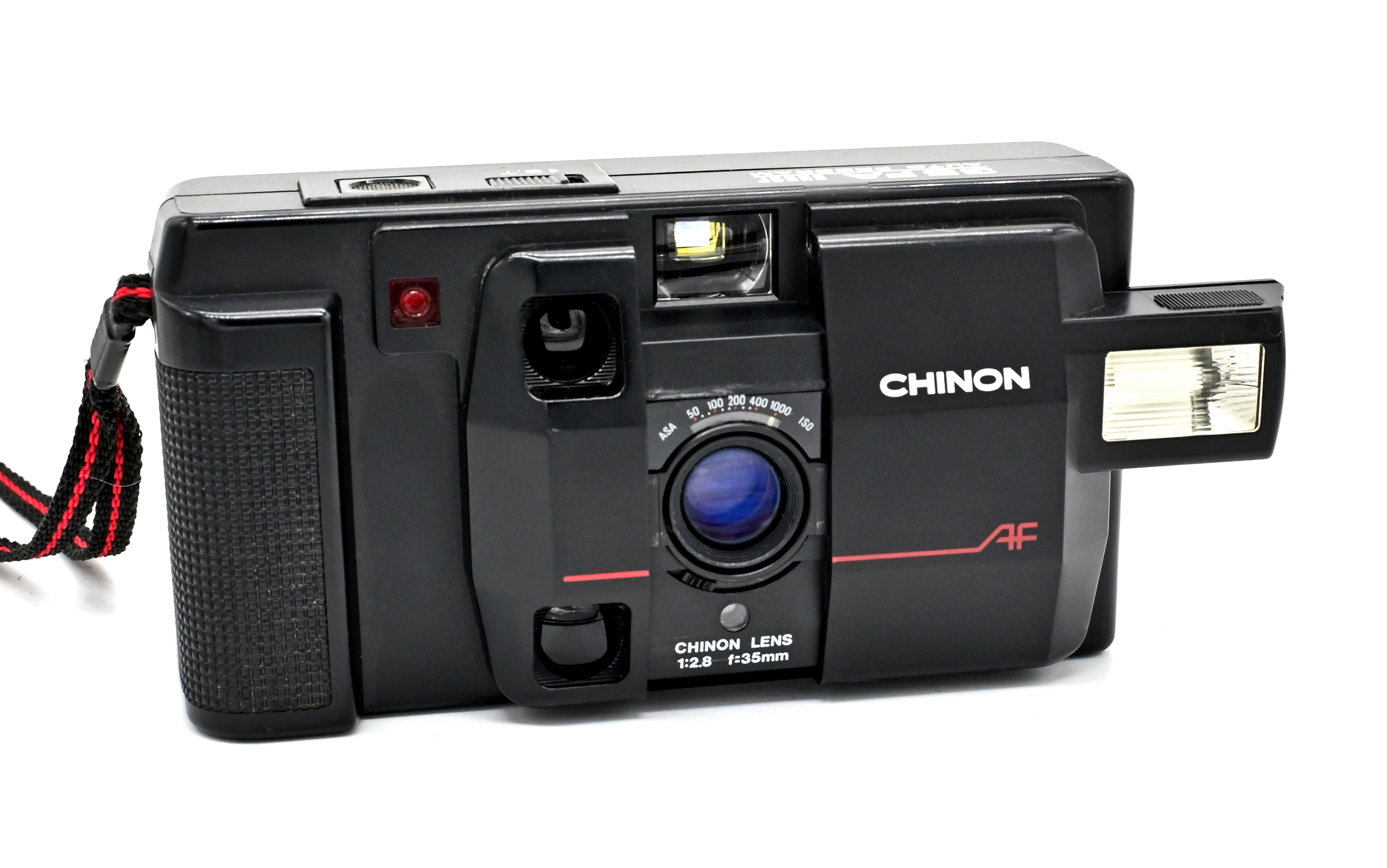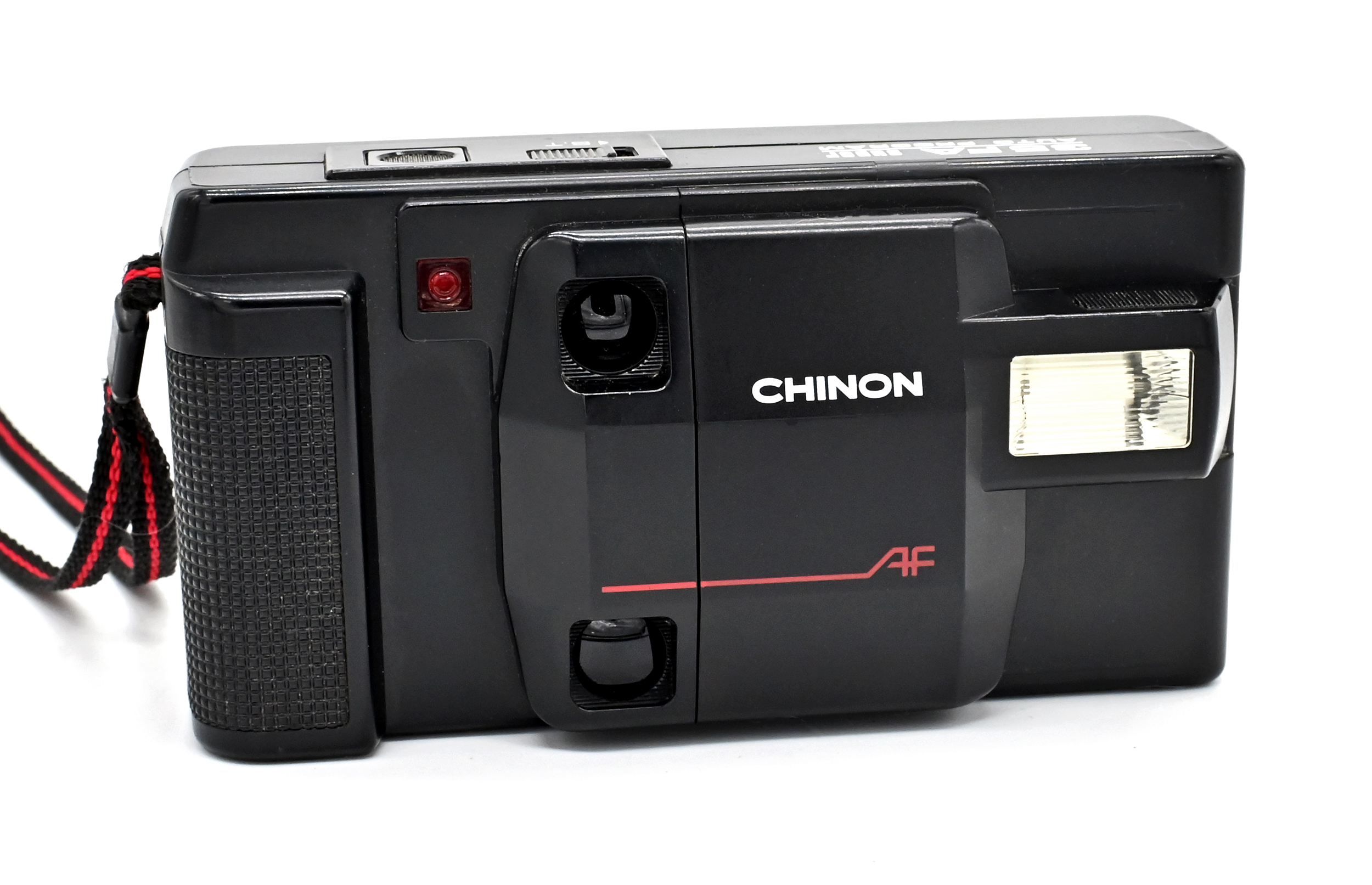
By 1984, the concept of the modern point & shoot camera had begun to emerge. No longer would people be expected to set apertures, manually load film, focus lenses, or figure out how to use a flash. 35mm photography would no longer require so much technical skill, but just extraordinary vision. But does this early generation of 35mm film cameras have any place in the 21st century? Maybe?
In 1984, every major Japanese manufacturer introduced very similarly-featured point and shoot 35mm cameras with a “sliding door” to cover a diminutive lens. These cameras may be properly considered the “second generation” of modern point-and-shoots.
The high-end range of this generation included the Canon MC, the Chinon 35FA Super, the Minolta AF-C, the Pentax PC35AF-M, and the Vivitar TEC 35. Each had a 35/2.8 Tessar-style lens, a built-in or clip-on flash, a primitive autofocusing system, automatic film advance and rewind, and user-selected ASA settings from 25/50, 100, 200, 400, and 1000. Some of these manufacturers sold cheaper, de-featured versions of these cameras; but we will leave discussion of those to the recycling center of history.
We were not going to endeavor to pick up examples of all of these cameras as: (a) these former thrift-store bargains are now selling for a premium on eBay, Etsy, and online camera stores; and (b) these cameras have mostly the same features, with minor some variations. Given the slight technical differences and overall similarity in functionality in all of these cameras, it hard to say whether any of them are the “best” of the class. Of note, the Pentax focuses down to 0.7m at the trade-off of having to use DX-coded film cassettes (or otherwise default to ASA 100). It is possible that certain lenses excel over others, but that would difficult to evaluate without testing them all against each other. One could assume that despite slightly different lens designs, they probably perform pretty similarly.
WARNING: The primary drawback of all of the cameras of this class is the lack of reliable autofocus at closer distances. Although most will provide some kind of viewfinder LED indicating close, medium, and far focusing, these cameras will not indicate to you what it has actually focused on. The flash operation is equally quirky and dependent upon an accurate autofocus in the first place. None of these cameras are well-suited for any critical work – you will miss plenty of close-up photos and not realize it. The ability of point & shoots to provide accurate autofocusing feedback did not come until years later. However, as a snapshot camera for subjects within the lens’ depth-of-field, they work moderately well.
The 35FA Super was at the top tier of the 1984 gamut. The essential features were: (1) a 35/2.8 lens; (2) manual ASA settings up to 1000; (3) an underexposure warning; (4) a built-in flash; (5) automatic film loading and rewinding; (6) focus confirmation in the viewfinder (close, medium, far away); (7) a self-timer; (8) auto-focus lock; and (9) automatic daylight fill-flash. And you can open the shutter cover and take a photo far faster than you can retrieve your iPhone out of your back pocket.
Early autofocus cameras will seem bizarre to anyone used to the moving lenses of SLRs. During the 1970s, the American company Honeywell patented the first commercially-useful autofocus system. In a nutshell, two sensors on the camera would triangulate the distance to the subject (much how a rangefinder focuses) and then transmit the distance information to the camera. The lens itself does not pre-focus, it will do so in the instant after the shutter is depressed. Japanese camera manufacturers were the first to license and figure out how to build a camera around this technology – starting with the revolutionary Konica C35 AF in 1977.
The 35FA Super has impressive mid-1980s industrial design. Sliding open the lens door powers on the camera. The fixed lens trades image quality for versatility. The camera is eminently pocketable. Check out the manual here.

Loud: The 35FA has an incredibly loud shutter and film advance mechanism. And it is not a pleasant sound. This is not for your secret “street photography.”
35/2.8 Glass Lens: The modern fast Tessar lens design has its origins in 1930. In archetypal form, it is a four element, three group design. The minimum focusing distance on the 35FA Super is 1 meter — the industry standard for the time.
Bright Finder: The 35FA has a bright, non automatically parallax-corrected viewfinder. It has etched parallax correction framelines for shorter focusing distances. It would be some time before an autofocus point and shoot would have automatically-corrected framelines.
Underexposure Warning and Focusing Verification: The camera will warn you with a red LED just to the left of the viewfinder if the shot will be underexposed. The viewfinder also displays the approximate location of the focusing — close up, medium range, and infinity — in cute little icons.
Autofocus and Exposure Lock: By depressing the shutter slightly, the camera will lock both the focus point and the exposure so you can reframe. These are essential features for any useful point and shoot.
Auto-Rewind: With a switch on the base, the camera will auto-rewind the film and automatically stop when completed.
Built-in Fill Flash: A sliding lever turns on the flash. A yellow indicator will alight when the flash is charged. The camera has an “auto” daylight fill flash capability — turn on the flash for daylight shots and it will do an ok job of filling in shadows.
User-Selected ASA 50 to 1000: From ASA 50 to 400 the 35FA can adjust in 1/3 increments. This is the only camera in this class that do this. There are no increments over 400 — just straight from 400 to 1000. Also, no DX coding like later point and shoots. So if you roll your own film with generic cassettes, there is no annoyingness.
Optional Date Back Model: I have no idea why Japanese cameras were so big on date backs — a feature that imprints the current date on the negative. Many of these data backs only went up to 2019. Whomp.
Recommendation: For cameras of this class, the Chinon checks all of the boxes. The most useful feature is its fast operation. Autofocus lock and exposure lock make this camera as useful as any larger SLR. The only feature that it lacks is the 0.7m minimum focus of the Pentax. The biggest drawbacks are that it is loud and has spotty autofocus.